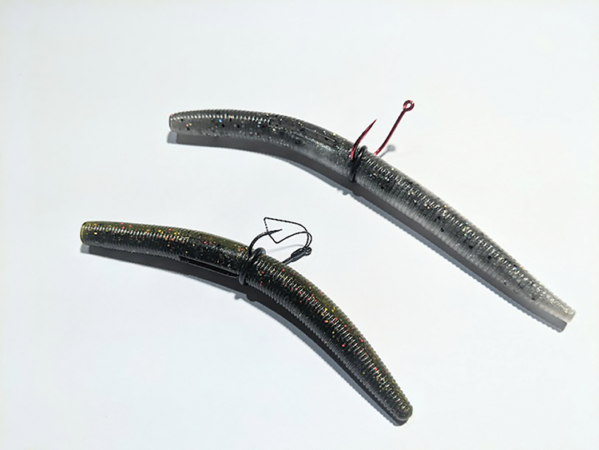So, what’s a wacky worm? Well, it’s a soft rubber or plastic worm made, for the most part, for bass fishing.
Artificial worms have been around for a long time, but fishermen are constantly coming up with new ways of rigging plastic worms and other soft plastics, and the wacky worm is a good example.
I had been using worm rigs for a long time utilizing the standard Texas rig with the cone sinker, and the Carolina rig with the sinker moved a short distance from the worm so it would ride a bit off the bottom. When I finally got a firsthand look at a wacky rig, I’ll admit that I wasn’t too impressed.
My first experience with the wacky rig came about a number of years ago when I was filming a TV show for “Pennsylvania Outdoor Life,” and a friend from the TV station was fishing a wacky worm. I was fishing my usual Texas rig, but my fishing buddy was hooking up a lot more often, and it didn’t take me long to start working the wacky rig. Now don’t get me wrong, I haven’t stopped using the other methods for rigging soft plastic worms, but I have certainly added the wacky worm to my regular list of bass lures.
The name describes the rig pretty well — “wacky rig.” What’s different is the worm is simply hooked right through the middle with both ends floppy down. To help keep the worm from tearing off so easily, it’s a good idea to slide the right-sized rubber ring casket to the center of the worm and then run the hook through it and the worm. There are a number of companies that make worms just for wacky rigging; they are usually salt impregnated, so they sink slowly, and both ends tend to be blunt and rounded. Most of the time, no weight is needed, but on occasion, a split shot can be added a foot or so above the worm to sink faster in deeper water.
The best way to fish the wacky rig is probably with an open-faced spinning outfit. I use six or eight-pound test mono, but I’m starting to use a more braided line now since it’s much more sensitive and has less stretch when setting the hook. I think one of the big keys to success with the wacky worm is immediately after the cast, raise the rod tip up and keep a tight line even while the worm rig is slowly falling through the water column. The tight line allows for any hits to be quickly telegraphed back to the angler and, after a very slight pause, set the hook. I have picked up a number of basses even on the drop; simply watch for a slight movement of the line in any direction, and you likely have a fish taking the rig.
I use the wacky rig for both largemouths and smallmouths, although I have also taken pickerel, pike, and even walleyes with this rig. It is productive in both rivers and lakes and if fishing in or around any kind of weeds or structure, simply use a hook with a weed guard. I prefer the Gamakatsu size 2 Octopus style hook in red or a Diaiichi in size 2/0 also in red, although I’m not sure the red hook is all that significant. Wacky worms usually range in size from three inches to five or six inches, and they come in the usual variety of colors. Some of my best action has been with the silvery flecked worm, but browns, greens, blacks, blues, and purples have all produced for me.
Recently I had my first bass outing of the year, and I caught and released over a half-dozen bass, with a couple nearing the 20-inch mark; my lure of choice was a four-inch green with sparkles wacky worm. You can bet that I haven’t lost any confidence in the wacky worm.




